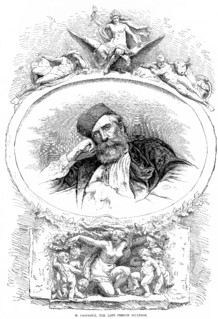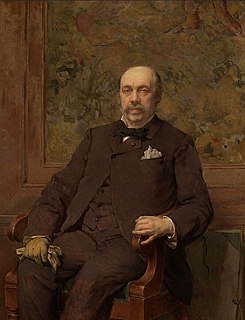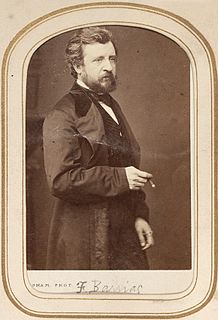
Jean-Baptiste Carpeaux was a French sculptor and painter during the Second Empire under Napoleon III.

Baron François Joseph Bosio was a Monegasque sculptor who achieved distinction in the first quarter of the nineteenth century with his work for Napoleon and for the restored French monarchy.

Léon Joseph Florentin Bonnat was a French painter, Grand Officer of the Légion d'honneur and professor at the Ecole des Beaux Arts.

Philippe-Joseph-Benjamin Buchez (1796–1865), more commonly called Philippe Buchez, was a French historian, sociologist, and politician. He was the founder of the newspaper L'Atelier, and he served briefly, in 1848, as the president of the Constituent National Assembly, which was then meeting at the Palais Bourbon in Paris.

Lambert-Sigisbert Adam was a French sculptor born in 1700 in Nancy. The eldest son of sculptor Jacob-Sigisbert Adam, he was known as Adam l’aîné to distinguish him from his two sculptor brothers Nicolas-Sébastien Adam, known as "Adam le jeune", and François Gaspard Balthazar Adam. His sister Anne Adam married Thomas Michel, an undistinguished sculptor, and became the mother of famous sculptor Claude Michel, known as Clodion, who received his early training in the studio of his uncle Lambert-Sigisbert.

Jean-François Portaels or Jan Portaels was a Belgian painter of genre scenes, biblical stories, landscapes, portraits and orientalist subjects. He was also a teacher and director of the Academy of Fine Arts of Ghent and the Académie Royale des Beaux-Arts in Brussels. He is regarded as the founder of the Belgian Orientalist school. He was praised in his time as the premier painter of 'everyday elegance and feminine grace'. Through his art, teaching and his leadership of the Académie Royale in Brussels he exerted an important influence on the next generation of Belgian artists, including his pupil Théo van Rysselberghe.

Jean-Baptiste Jacques Augustin was a French miniature painter.

Louis-Simon Boizot (1743–1809) was a French sculptor whose models for biscuit figures for Sèvres porcelain are better-known than his large-scale sculptures.

Joseph-Siffred Duplessis was a French painter known for the clarity and immediacy of his portraits.

Henri Lehmann was a German-born French historical painter and portraitist.

Jean-Pierre Dantan, known as Dantan the Younger, was a French portrait sculptor. His subjects include many famous figures from the realms of politics, music and the arts, and literature. He is said to be the inventor of the sculptural caricature.

Juste or Giusti is the name conventionally applied to a family of Italian sculptors.

Édouard Joseph Dantan was a French painter in the classical tradition. He was widely recognized in his day, although he was subsequently eclipsed by painters with more modern styles.

Agostina Segatori was a famous model who posed for celebrated painters in Paris, France, such as Édouard Joseph Dantan, Jean-Baptiste-Camille Corot, Jean-Léon Gérôme, Eugène Delacroix, Vincent van Gogh and Édouard Manet. She is also known for running the Café du Tambourin in Paris.

Jules Joseph Augustin Laurens, commonly known as Jules Laurens, was a French artist in drawing, painting, and lithography who is remembered above all for his Oriental works.

Jean-Baptiste Vietty, was a French sculptor and archaeologist.

The Maître de Chaource was an unidentified sculptor who worked in the late 15th and early 16th century, in the French town of Chaource. While many works are attributed anonymously to him or his atelier, some scholars have identified Jacques Bachot as the artist. There is certainly circumstantial evidence which points to Bachot; he was a contemporary of the Maître de Chaource and often worked in the same locations and works by Bachot such as that in the church of Saint-Laurent in Joinville, of which fragments are held in the Joinville Town Hall, show great similarities to the work of the Maître de Chaource.

Félix-Joseph Barrias was a French painter. He was well known in his day for his paintings of religious, historical or mythical subjects, but has now been largely forgotten. Artists who trained in his studio and went on to achieve fame include Edgar Degas, Gustave Achille Guillaumet and Henri Pille.

Émile-Joseph Porphyre Pinchon was a French painter, illustrator, designer and comic book creator, best known for his series Bécassine.



















